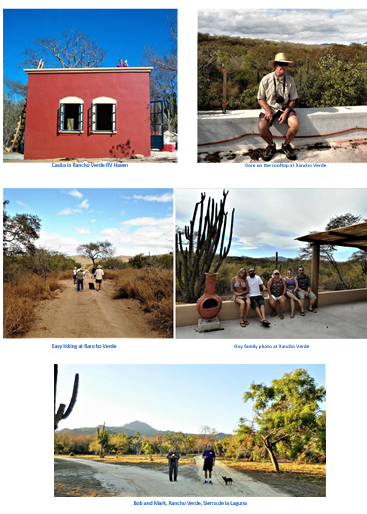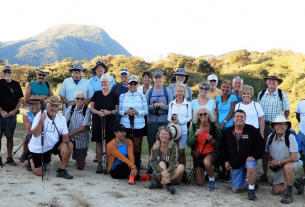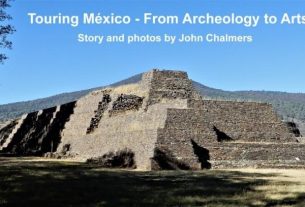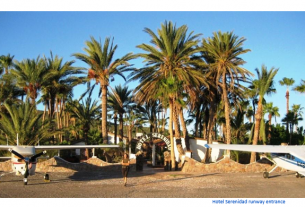By Dan and Liza Goy on the August 2020 Edition
Sierra de la Laguna, BCS
Exploring the northern foothills of Sierra de la Laguna from Mex 1
Our RV tours on Baja take us through the northern foothills of Sierra de la Laguna on Hwy 1 between La Paz and Los Barriles. We routinely stop for brunch and a look around in El Triunfo and then a short drive past San Antonio to our destination, Rancho Verde RV Haven, for the night.
The next day, we head off to Los Barriles on the East Cape, which takes us through San Bartolo as we descend to the coastline. For those that have more time, this entire region has lots to see and do, much different from your experiences in La Paz, Los Barriles or Los Cabos.
El Rosario
 Driving southbound on Hwy 1 before you get to El Triunfo is the Ejido community of El Rosario and the Cactus Sanctuary of Baja California Sur. Located only 45 minutes to the south of La Paz (the capital of the Mexican state of Baja California Sur), Santuario de los Cactus is 50 hectares of parkland which has been divided into 50 distinct areas to preserve cacti and endemic plants found only in this part of the globe. When we visited, some years ago, the entrance was open and no fee was collected. This was well worth a visit.
Driving southbound on Hwy 1 before you get to El Triunfo is the Ejido community of El Rosario and the Cactus Sanctuary of Baja California Sur. Located only 45 minutes to the south of La Paz (the capital of the Mexican state of Baja California Sur), Santuario de los Cactus is 50 hectares of parkland which has been divided into 50 distinct areas to preserve cacti and endemic plants found only in this part of the globe. When we visited, some years ago, the entrance was open and no fee was collected. This was well worth a visit.
There is a large sign on Mex 1 for the Cactus Sanctuary, on the right, when southbound. El Rosario itself is actually past the Sanctuary entrance and is very small. Often there are local crafts available, some unique pottery.
El Triunfo
 Although El Triunfo started as a cattle ranch in the early Jesuit period, it is best known as a former mining town that straddles Hwy 1. Located at an elevation of 483 meters (1,585 feet) above sea level, it has a population of under 800. Many RVers who travel to Baja, Mexico, often pass through El Triunfo with-out stopping at this unassuming town that is only about four blocks long.
Although El Triunfo started as a cattle ranch in the early Jesuit period, it is best known as a former mining town that straddles Hwy 1. Located at an elevation of 483 meters (1,585 feet) above sea level, it has a population of under 800. Many RVers who travel to Baja, Mexico, often pass through El Triunfo with-out stopping at this unassuming town that is only about four blocks long.
In many ways, the town has the feel of a turn-of-the-century movie set, complete with heritage building facades, a two-tone church, cobblestone streets and old smoke stacks. Snowbirds often drive through heading north to La Paz or south to Los Barriles, San José del Cabo or Cabo San Lucas.
The first mine in El Triunfo was established by Manuel de Ocio in 1748. Ownership of the mine was temporarily transferred to the Spanish Crown at one point and the mine remained largely unsuccessful. In 1862, silver and gold were discovered in the southern Baja California Sur Mountains, leading miners from Mexico and the United States to rush to settle in El Triunfo in a gold rush.
Many of the miners had participated in the 1849 California gold rush. In 1878, the mine was taken over by the British El Progreso Mining Company and became more successful. Once the largest city in Baja California Sur, it was home to more than 10,000 miners.
El Triunfo was the first town in the region to install electricity and telephones. In its heyday, the town was a cultural center, where Francisca Mendoza taught and performed. Pianos and other instruments were brought to El Triunfo from around the world. In fact, El Triunfo had more pianos per capita than any other city in Mexico, hence the music museum. Cultural life in-cluded regular concerts and two competing weekly newspapers.
When mines shut down in 1926, the town was largely abandoned. Parts of the old mine installations can still be seen, including two massive chimney stacks, “La Ramona”, 47 meters high, designed by famous French engineer Gustave Eiffel and named after Saint Raymond, on whose feast day the project was completed. After more than 100 years, the smokestack was cracked and damaged and collapse during an earthquake or hurricane was a concern. In 2018, the non-profit International Community Foundation (ICF) and the Corredor Histórico CAREM, A.C. collaborated to restore La Ramona for an estimat-ed $200,000 USD.
 Follow the path lined by the white rocks to head up to the mirador lookout, where you’ll get a beautiful view of the little town and the surrounding mountains. Halfway up the path to the mirador is a side jaunt to the walled-in Panteón Inglés cemetery, with 13 white aboveground mausoleums of English citizens who once worked in the mines.
Follow the path lined by the white rocks to head up to the mirador lookout, where you’ll get a beautiful view of the little town and the surrounding mountains. Halfway up the path to the mirador is a side jaunt to the walled-in Panteón Inglés cemetery, with 13 white aboveground mausoleums of English citizens who once worked in the mines.
The other chimney stack is “Julia”, near to which mining machinery manufactured in Chicago and San Francisco has lain rusting and forgotten since the mines closed. We understand a Museo de Plata is on the drawing board and the mining museum will be opening to the public soon. The museum will tell the history of the mine and the region through interactive exhibits that will bring to life the rich history of the area.
 The town has made impressive strides in the past decade to attract more tourists. The change in El Triunfo started slowly, a few years ago, when Marcus Spahr, who had previously run Caffé Todos Santos for 16 years, left the West Cape and opened Caffé El Triunfo. It turns out this was a game changer for this sleepy little town.
The town has made impressive strides in the past decade to attract more tourists. The change in El Triunfo started slowly, a few years ago, when Marcus Spahr, who had previously run Caffé Todos Santos for 16 years, left the West Cape and opened Caffé El Triunfo. It turns out this was a game changer for this sleepy little town.
It is much more than just the wood burning oven, freshly baked bread and pizza. Mark’s menu includes a “Chicken enchilada Omelette”! which comes with fried potatoes, fresh fruit, homemade bread and sliced avocado and crema. Our mouths water just thinking about it! One of our clients ordered the fish tacos and said they were the best, made with Ahi tuna! The oven-fired sourdough loaves are delicious, particularly the cranberry walnut, our favourite. Mark has done an outstanding job on this café and has really brought this little town to the fore-front for Baja travellers.
The mining ghost town that time once seemed to have forgot-ten is now abuzz with hundreds of tourists each weekend. Our first visits always include a visit to the wonderful music muse-um. On our last visit, once inside, we were greeted by Maestro Nicolás Carrillo Castro who personally conducted the tour of the museum. If you are fortunate, Sr. Castro would tickle the ivories for you. His flamboyant style will bring visions of a Mexican Liberace. Sitting in the audience as the Maestro is playing Beethoven and Bach on the Baldwin grand piano was truly an unforgettable experience. Sadly, Nicolás Carrillo, passed away a few years ago, and the museum has not been well taken care of since then, however still worth the 20 pesos and a visit.
In recent years, to attract tourism, many of the original build-ings have been restored and converted into restaurants, muse-ums, boutiques and other businesses. Caffé El Triunfo has re-cently been joined by the refreshingly chic Bar El Minero. The building that houses El Minero is over 120 years old and was once the laboratory for the mines.
 Today, the space is beautiful and inviting, with upcycled bottle light fixtures, locally crafted wood tables, and a long bar. The expansive outdoor space has plenty of seating, fire pits, and views of the old smokestacks. El Minero serves craft beer on tap, as well as house-made artisanal sausages, salads, and local cheeses. Chef Felipe studied at culinary schools in San Diego and Tijuana and his sophisticated understanding of flavor pro-files shines through in everything he makes. On Sundays, there is a large paella fest that draws locals and visitors for a very fun afternoon. Don’t visit without dressing up to take your photo with the bronze sculpture of Sofia and Juan Matute in the courtyard. All of the attention is leaving some people wondering is El Triunfo, the next Baja “it” spot? We believe it is.
Today, the space is beautiful and inviting, with upcycled bottle light fixtures, locally crafted wood tables, and a long bar. The expansive outdoor space has plenty of seating, fire pits, and views of the old smokestacks. El Minero serves craft beer on tap, as well as house-made artisanal sausages, salads, and local cheeses. Chef Felipe studied at culinary schools in San Diego and Tijuana and his sophisticated understanding of flavor pro-files shines through in everything he makes. On Sundays, there is a large paella fest that draws locals and visitors for a very fun afternoon. Don’t visit without dressing up to take your photo with the bronze sculpture of Sofia and Juan Matute in the courtyard. All of the attention is leaving some people wondering is El Triunfo, the next Baja “it” spot? We believe it is.
 San Antonio
San Antonio
San Antonio has about 400 inhabitants, situated at 400 meters (1,312 ft.). Loreto was the original capital of the peninsula until 1830, when destruction of the town by heavy rains forced the government’s relocation to San Antonio for 2 years before moving to La Paz, which has been the capital since. The inhab-itants of San Antonio are overwhelmingly in favour of the Los Cardones Gold Mine as they stand to benefit immensely since a great deal of the mine sits on Ejido land.
Rancho Verde RV Haven
Rancho Verde RV Haven (GPS 23.76278 N, 109.97944 W) is located on a 3100-acre ranch in the Sierra de la Laguna mountains, just off Highway 1, at kilometre 142, between San Bartolo to the south and San Antonio to the north, at an elevation of 1700 Feet/520 Meters in the Sierra de la Laguna Mountains.
This is an operating 3100-acre ranch, that includes a 200 acre “RV Haven” with an accompanying campground.
This campground has potable water for water containers, a dump station at every site, but no electricity. Please do not wash your vehicle or fill up your tanks. Water is in short supply. The showers are hot and they have flush toilets.
Here, you can enjoy hot sunny days and cool nights with gorgeous vistas and sunsets. There are miles of trails for hiking and the bird watching here is fantastic!
We always ask our guests not to run their generators for air conditioning. Although it may be very hot when they arrive, when the sun goes down, Mother Earth’s AC turns on. It has been 38C (100F) when we arrive and 5C (40F) at sunrise. The serenity is precious!
 Wi-Fi with AC power is available at the common building cen-tral to the campground as are hot showers and flush toilets just a short stroll away. The rates; daily, weekly or monthly are very reasonable. You can tent or take your big rig. Everyone is welcome and all sizes can fit. On the ranch itself, there are miles/ kilometres of trails for hiking, horseback riding (see the rancho next door), ATVing or dirt biking. Lots to see and the vistas are stunning.
Wi-Fi with AC power is available at the common building cen-tral to the campground as are hot showers and flush toilets just a short stroll away. The rates; daily, weekly or monthly are very reasonable. You can tent or take your big rig. Everyone is welcome and all sizes can fit. On the ranch itself, there are miles/ kilometres of trails for hiking, horseback riding (see the rancho next door), ATVing or dirt biking. Lots to see and the vistas are stunning.
This campground is one of our favourites because it is so very different from all the others in Baja Sur. It also often reminds us of camping in the mountains back in British Columbia, Canada. Rancho Verde “RV Haven” advertises “…a relaxed atmosphere only minutes from the hectic life of the beach communities the real Mexican lifestyle that everyone is seeking and hardly finds! Peaceful, carefree living amid scenic wilderness and mountains of greenery, a beachfront launch site, guided fishing tours for those without boats, and a total security package for your peace of mind while you are away from the premises” and they deliver.
 This ranch is also a bird watchers’ paradise. Fred and Joyce Harrington spent a week in February of 2008 at Rancho Verde and reported observing over 50 species of birds including many varieties of hawks, owls, doves, hummingbirds, woodpeckers,wrens, warblers and flycatchers. A pair of resident Crested Caracaras can often be seen in the horse paddock as visitors arrive and, if you scatter some birdseed, provide a bowl of water or put out a hummingbird feeder, we guarantee other birds will show up. For Campers and RVers, Rancho Verde is an excellent location to stage from for day trips about and around this very unique and interesting region.
This ranch is also a bird watchers’ paradise. Fred and Joyce Harrington spent a week in February of 2008 at Rancho Verde and reported observing over 50 species of birds including many varieties of hawks, owls, doves, hummingbirds, woodpeckers,wrens, warblers and flycatchers. A pair of resident Crested Caracaras can often be seen in the horse paddock as visitors arrive and, if you scatter some birdseed, provide a bowl of water or put out a hummingbird feeder, we guarantee other birds will show up. For Campers and RVers, Rancho Verde is an excellent location to stage from for day trips about and around this very unique and interesting region.
San Bartolo is a scenic tropical village, complete with thatched roof homes, 10 miles north of Los Barriles, as you begin your climb into the hills. This is a great place to return to and buy mangos, avocados, locally made candies and some of the most incredible of the local treats, fruit filled empanadas. A large, spring-fed arroyo runs along the base of the valley and pro-vides this pleasant town with a bountiful supply of fresh water. ATV trips from Los Barriles are very popular. They simply drive from the beachside community up the dry arroyo. Our guests have participated in many.
Sierra de la Laguna
The Sierra de la Laguna is a mountain range at the southern end of the Baja California Peninsula in Mexico, and is the southernmost range of the Peninsular Ranges System. It is located in both the La Paz Municipality and Los Cabos Municipality. The “Sierra de la Laguna High Point”, at 6,857 feet (2,090 m) in elevation, is the highest point of the range and in Baja California Sur state. Not well known is that the southern tip of the Baja California Peninsula, including the Sierra de la Laguna, was formerly an island in prehistoric times. It has a distinctive flora and fauna, with many affinities to Southwestern Mexico. The Sierra is home to many endemic species and subspecies.
The dry San Lucan xeric scrub Eco region extends from the sea level at the coast to 250 metres (820 ft) in elevation. The Sierra de la Laguna dry forests Eco region occupies the lower portion of the range, from 250 – 800 metres (820 – 2,620 ft) in elevation. Above 800 metres (2,600 ft) in elevation, the dry forests transition to the Sierra de la Laguna pine-oak forests Eco region.
The composition of the pine-oak forests varies with elevation. Oak woodlands predominate, from 800 – 1,200 metres (2,600 – 3,900 ft) in elevation, with oak-pine woodlands between 1,200 – 1,600 metres (3,900 – 5,200 ft) in elevation, transitioning to pine -oak forests above 1,600 metres (5,200 ft) in elevation. The pre-dominant pine is a local subspecies of Mexican Pinyon, Pinus cembroides subspecies lagunae. The forests are exploited com-mercially for timber and cattle raising is common in the oak woodland and dry forest zones.
Biosphere Reserve
UNESCO has designated the Sierra de la Laguna a global biosphere reserve: “This semi arid to temperate, sub humid climate area represents highly important and contrasted ecosystems,including arid zones, matorrales, low deciduous forest type, evergreen oak: Quercus devia (“encino”) woods, pine evergreen oak mix woods and oases with palms and “guerivos” situated throughout the gallery forest following the long river basins.”
The Biosphere reserve was established by a Mexican presidential decree of 6 June 1994 which designated a core area and buffer zones. The core area is centered on the higher elevation oak pine forests, while the transition area includes the communities of Todos Santos, El Pescadero, El Triunfo, San Antonio, San Bartolo, Buena Vista, Los Barriles, Las Cuevas, Santiago and Miraflores.
Los Cardones Gold Mine
In November 2012, the federal Environment and Natural Re-sources Secretariat refused a request to allow open-pit (opencast) mining in the buffer zone of the Sierra La Laguna Biosphere Reserve in Baja California Sur. The request came from Zapal SA de CV whose mining project, currently named “Los Cardones”, is located about 60 km from La Paz, the state capital. The project involved 423 hectares of semi-arid scrubland from which Zapal hoped to extract 40 metric tons(estimated reserves of 1.2 million ounces) of gold in the next decade. The $217-million project would have created around 2200 jobs. Controversy has embroiled this project from Day 1 with locals and expats.
 The project is close to the small settlements of El Triunfo, San Antonio and El Rosario. This mining project was previously called “Paredones Amarillos” and “La Concordia”. The original Concordia project, proposed by US mining firm Vista Gold and Toronto-listed Argonaut, was opposed on environmental and public health grounds by several environmental groups including the Mexican Center for Environmental Law (CEMDA). A tribunal quashed the original environmental permit issued for a controversial gold mine in Baja California Sur.
The project is close to the small settlements of El Triunfo, San Antonio and El Rosario. This mining project was previously called “Paredones Amarillos” and “La Concordia”. The original Concordia project, proposed by US mining firm Vista Gold and Toronto-listed Argonaut, was opposed on environmental and public health grounds by several environmental groups including the Mexican Center for Environmental Law (CEMDA). A tribunal quashed the original environmental permit issued for a controversial gold mine in Baja California Sur.
The latest version, Los Cardones, was resubmitted to authorities in September 2014, submitted by the mine’s developer, De-sarollos Zapal, a subsidiary of Invecture, a Mexican firm linked to Grupo Salinas. Mine opponent, Irina Trasviña of Frente Ciu-dadano, or Citizens’ Movement, said the ruling against the pro-ject represented “a national and international precedent that has succeeded in stopping, for the fourth time, a mining mega-project that threatens our water and consequently our quality of life.” In 2017, a federal tribunal quashed an environmental permit that had been issued for it.
Last September (2018), residents demanded that then president elect López Obrador commit to stopping the mine from going ahead but, at the time he was non-committal and instead pro-posed a consultation.
On March 3, 2019, President Andrés Manuel López Obrador announced the cancellation of the project to exploit the Los Cardones open pit gold mine, promoted by the company Desarrollos Zapal.
The president had said previously that the proposed Los Cardones open pit mine project, located within a buffer zone of the Sierra de Laguna biosphere reserve in the municipality of La Paz, would be put to a public consultation but that plan has now been scrapped. The president explained that he did not support the mine because “we have to look after paradise, not destroy paradise.”
 |
 |
 |
 |
 |
 |
Dan and Lisa Goy, owners of Baja Amigos RV Caravan Tours, have been making Mexico their second home for more than 30 years and love to introduce Mexico to newcomers.




